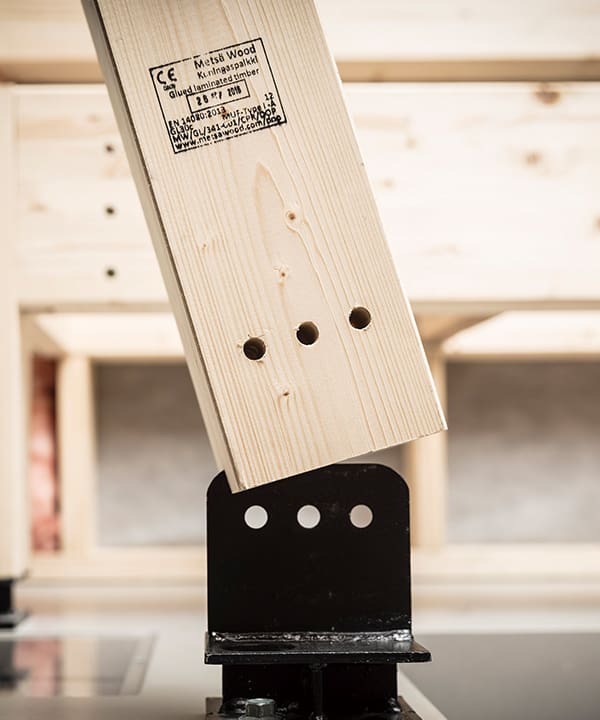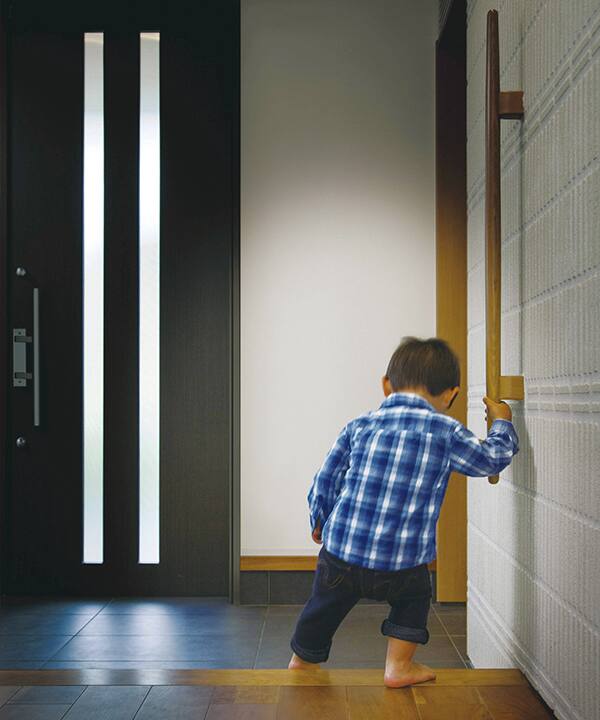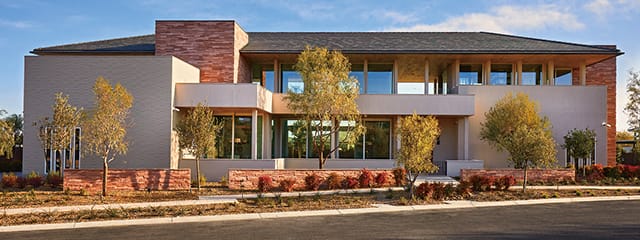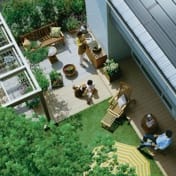International BusinessUnited States
Applying Sekisui House technology: Responding to the various natural disasters that can occur in large land areas

Interior of the SHAWOOD concept home, built to ZEH standard and with high seismic resistance (see page 60)
Challenge
- Strong demand for housing due to high population growth
- A population motivated to fight global warming due to possibly related occurrences, such as shifting paths of hurricane
- A high risk of powerful earthquakes along the West Coast of North America
- A need for ongoing maintenance of building exteriors
Response
- Acquisition of Woodside Homes and expanded collaboration efforts
- Transplanting of Sekisui House technology
- Construction of SHAWOOD, which is built to ZEH standard and features high seismic resistance
- Introduced Bellburn ceramic wall product
Adopting ZEH standards across the U.S.A. from California

ZNE housing in California
California is an environmentally advanced state that has been proactively adopting environmental regulations. Reductions in greenhouse gas emissions have been legislated, and legislation requiring new homes to be equipped with photovoltaic panels was introduced in 2020, marking the first time such a policy has been adopted in the United States. Our subsidiary, Woodside Homes, is strengthening the development of environmentfriendly and lifestyle-oriented products to promote zero net energy housing (or ZNE, the industry term in the U.S.A.) in line with revisions to the state's environmental and energy-efficiency standards for buildings. We are providing ZEH housing as a foothold for popularizing this innovation in the United States, and we are planning to introduce environment-friendly urban developments in the future.
Development projects focused on biodiversity
Highlights
The first SHAWOOD concept home in the U.S.A. was unveiled at IBS 2020.
In January 2020, we participated as the first Japanese house builder to exhibit at the International Builders' Show (IBS), the largest U.S. trade fair for housing, held in Las Vegas.* In addition to hosting an exhibit at our booth, we constructed a SHAWOOD concept home (an original wooden house design of Sekisui House) in the Summerlin area of western Las Vegas and opened it to the public. This marked the debut of the SHAWOOD house in the United States, and interest was very high. This also represented a valuable opportunity for us to convey our commitment to making a better society through housing.
The SHAWOOD brand, an initiative intended to resolve housing issues

The SHAWOOD Concept House is a structure built to the ZEH (Net-Zero Energy House) standard that offers high earthquake resistance and photovoltaic power generation capability with storage batteries. It is constructed with fireproof and low-maintenance Bellburn ceramic exterior wall material. This concept home earned high praise from participants, as it demonstrated a path to resolving some of the social issues facing the United States. It was designed to address the issues of life balance, connection with nature, symbiosis, and the design seeks harmony between Eastern and Western living customs, the concepts of indoors and outdoors, and a balance between technology and privacy.
By showcasing these technologies in the United States, we seek to provide helpful solutions. We will continue to promote the adoption of the SHAWOOD concept in the United States, incorporating sales methods that offer health and a choice of lifestyles.
Highlights of the SHAWOOD Concept Home

Beauty
- Bellburn
- Clear view design
- Broad horizontal roof design

Strength
- Structural laminated wood
- Metal joint construction
- Earthquake resistance

Functionality
- Net-Zero Energy House standard
- Smart UD
- Fresh interior air

Concept home constructed in the Summerlin area of western Las Vegas
Sustainability Report 2020 TOP
Contributing to Health, Longevity and Wealth
Pursuing Customer Satisfaction through Our Value Chain TOP
Action policies ② Meticulous supply chain management for material procurement
Action policies ③ Enhancing production and distribution quality and improving operational efficiency
Action policies ④ Strengthening our workmanship and maximizing our construction capabilities
Basic concept & Action policies | Promoting Diversity
Basic concept & Action policies | Workstyle Reforms
Basic concept & Action policies | Human Resource Development
Independent Third-Party Assurance Report




Our research of various display materials suggests we were the first Japanese housebuilder to exhibit at IBS, an annual housing fair that attracts more than 85,000 participants involved in the construction industry as well as institutional investors from around the world. Our concept home was an actual real-life exhibit presented by one selected company. We constructed it in collaboration with Woodside Homes.